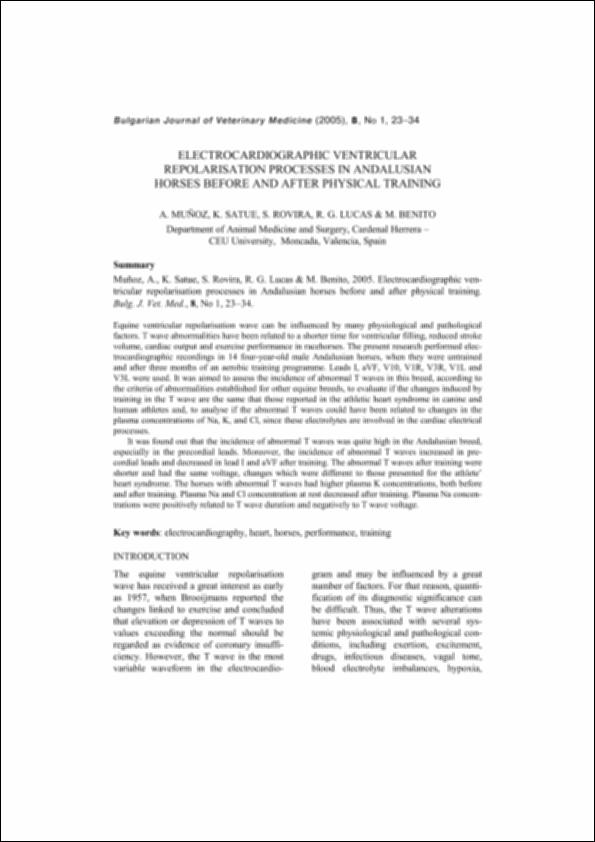Please use this identifier to cite or link to this item:
http://hdl.handle.net/10637/15454Electrocardiographic ventricular repolarisation processes in Andalusian horses before and after physical training
| Title: | Electrocardiographic ventricular repolarisation processes in Andalusian horses before and after physical training |
| Authors : | Muñoz Juzado, Ana Satué Ambrojo, Katiuska Rovira Cardete, Sabina Gómez Lucas, Raquel Benito Hernández, Milagros |
| Keywords: | Caballos; Horses; Ejercicio físico; Exercise; Rendimiento; Performance; Electrocardiografía en veterinaria; Veterinary electrocardiography; Corazón; Heart; Entrenamiento; Training |
| Publisher: | Trakia University, Faculty of Veterinary Medicine |
| Citation: | Muñoz, A., Satue, K., Rovira, S., Gómez, R. & Benito, M. (2005). Electrocardiographic ventricular repolarisation processes in Andalusian horses before and after physical training. Bulgarian Journal of Veterinary Medicine, vol. 8, i. 1 (mar.), pp. 23-34. |
| Abstract: | Equine ventricular repolarisation wave can be influenced by many physiological and pathological factors. T wave abnormalities have been related to a shorter time for ventricular filling, reduced stroke volume, cardiac output and exercise performance in racehorses. The present research performed electrocardiographic recordings in 14 four-year-old male Andalusian horses, when they were untrained and after three months of an aerobic training programme. Leads I, aVF, V10, V1R, V3R, V1L and V3L were used. It was aimed to assess the incidence of abnormal T waves in this breed, according to the criteria of abnormalities established for other equine breeds, to evaluate if the changes induced by training in the T wave are the same that those reported in the athletic heart syndrome in canine and human athletes and, to analyse if the abnormal T waves could have been related to changes in the plasma concentrations of Na, K, and Cl, since these electrolytes are involved in the cardiac electrical processes. It was found out that the incidence of abnormal T waves was quite high in the Andalusian breed, especially in the precordial leads. Moreover, the incidence of abnormal T waves increased in precordial leads and decreased in lead I and aVF after training. The abnormal T waves after training were shorter and had the same voltage, changes which were different to those presented for the athlete’ heart syndrome. The horses with abnormal T waves had higher plasma K concentrations, both before and after training. Plasma Na and Cl concentration at rest decreased after training. Plasma Na concentrations were positively related to T wave duration and negatively to T wave voltage. |
| URI: | http://hdl.handle.net/10637/15454 |
| Rights : | http://creativecommons.org/licenses/by-nc-nd/4.0/deed.es Open Access |
| ISSN: | 1311-1477 1313-3543 (Electrónico) |
| Issue Date: | Mar-2005 |
| Center : | Universidad Cardenal Herrera-CEU |
| Appears in Collections: | Dpto. Medicina y Cirugía Animal |
Items in DSpace are protected by copyright, with all rights reserved, unless otherwise indicated.


